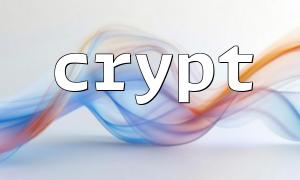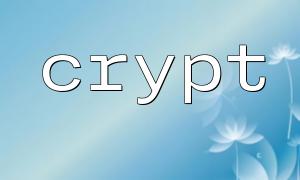In PHP, the crypt() function is usually used to hash the password, and its original intention is to verify the password, not for data encryption or signature. But in some practical projects, developers may try to use crypt() for other purposes, such as encrypting or signing URLs. This article will analyze whether the crypt() function is suitable for URL encryption or signature, and its security and effectiveness in this regard.
The crypt() function is a function for one-way encryption. It hash the input string based on different algorithms (such as DES, MD5, Blowfish, SHA-256, SHA-512). The typical usage is as follows:
$hash = crypt("password", '$6$rounds=5000$usesomesillystringforsalt$');
The second parameter of the function is "salt", which plays a role in determining the algorithm and affecting the output during the hashing process.
Encryption means you can restore the original content, and crypt() is an irreversible hash function. Once you use crypt() to process the URL (such as https://m66.net/download/file?id=12345 ), the result is a non-restoreable hash string. For example:
$url = "https://m66.net/download/file?id=12345";
$hash = crypt($url, '$6$rounds=5000$somesaltvalue$');
This code generates a string of hash values, but you can't restore the original URL from it. Therefore, crypt() is not suitable as an encryption tool.
Although crypt() is essentially a one-way hash function and can theoretically be used as a signature tool, it is not recommended in practice. The reasons are as follows:
The processing of salt is uncontrollable : the salt value must be generated and saved by yourself, otherwise you will not be able to verify the signature. Using dynamic salt values will result in different outputs for the same input, resulting in no signature verification.
Not cross-platform verification : Different systems may implement crypt() differently, especially when using specific algorithms (such as SHA-512), compatibility issues may arise.
The output format is complex and is not suitable for URL : the generated hash string may contain special characters such as / and $ , and additional encoding is required to be used in URL parameters, which increases the complexity:
$signed = urlencode(crypt($url, '$6$somesaltvalue$'));
// For link examples:https://m66.net/download/file?id=12345&sig=HASH_STRING
Unable to verify authenticity : The essential goal of crypt() is password verification, not ensuring data integrity. Compared with HMAC, it lacks mechanism support in the signature verification process.
If you need to sign the URL to ensure its integrity and tamper-proof, it is recommended to use the hash_hmac() function, which is designed for this scenario.
$url = "https://m66.net/download/file?id=12345";
$secret = "my_secret_key";
$signature = hash_hmac('sha256', $url, $secret);
$signedUrl = $url . "&sig=" . $signature;
// Recalculate during verification hash_hmac(url, secret) Conduct comparison
The HMAC signature is symmetric, provided that the server saves the key. This method not only ensures that the data has not been tampered with, but also applies to cross-platform verification.
The crypt() function is not suitable for encryption of URLs because it is an irreversible hash function and cannot restore the original data. At the same time, it is not suitable for URL signatures, as its security, compatibility and flexibility are not as good as professional tools such as HMAC. When it comes to URL signatures or verification scenarios, it is recommended to use hash_hmac() or other encryption libraries (such as openssl_sign() ) to ensure data integrity and security. For URL encryption requirements, symmetric or asymmetric encryption algorithms (such as AES, RSA) should be implemented instead of crypt() .
Related Tags:
URL














